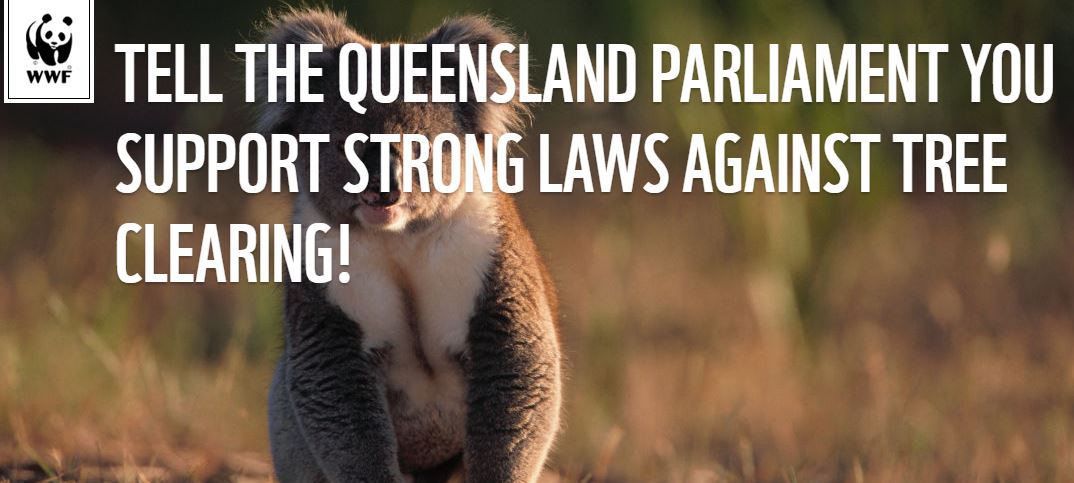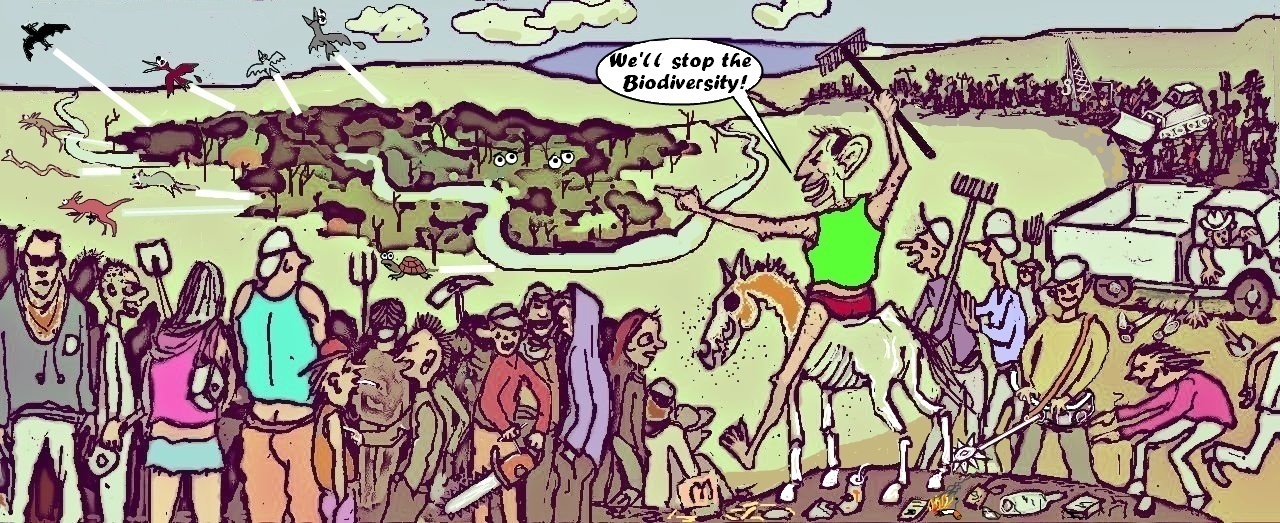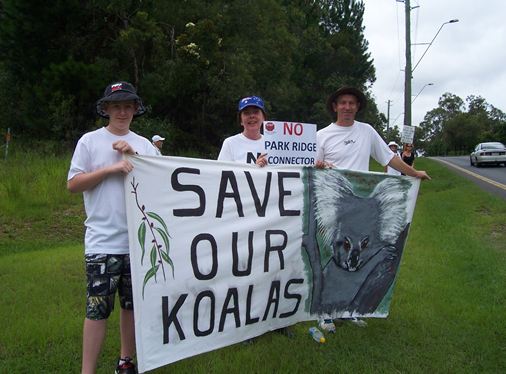
Logan and Albert Conservation Association

EXTENSION for deadline for submissions on the Vegetation Management (Reinstatement) Bill to
Friday 29 April 2016! - update provided by The Environmental Defenders Office Qld.
A hand written letter or text document can be posted / faxed to 07 3553 6699 / emailed to This email address is being protected from spambots. You need JavaScript enabled to view it.
Postal address Research Director
Agriculture and Environment Committee
Parliament House
BRISBANE QLD 4000
Submissions must include:
 To have this significant legislation re-instated is vitally important for the future well-being of the land and all species and ecosystems that rely on a healthy forested landscape. CLICK ON WWF image above to make your submission online to your local state MP. Not all members of the opposition - or independants - are opposed to re-instatement of this legislation. It is also an opportunity extend the legislation to close loopholes. As WWF point out The VMROLA Bill is already a significant compromise. Damaging loopholes remain and should be closed.
To have this significant legislation re-instated is vitally important for the future well-being of the land and all species and ecosystems that rely on a healthy forested landscape. CLICK ON WWF image above to make your submission online to your local state MP. Not all members of the opposition - or independants - are opposed to re-instatement of this legislation. It is also an opportunity extend the legislation to close loopholes. As WWF point out The VMROLA Bill is already a significant compromise. Damaging loopholes remain and should be closed.  LACA will take the opportunity on
LACA will take the opportunity on
Sunday 2 pm, 20 March 2016 at
Shailer Park State High School Hall
to call for stronger than ever vegetation clearing laws, given the recent report by WWF World Wildlife Fund that during the Newman government year 2013-14 around 300 000 hectares (including 40 000 ha of Koala habitat) was cleared compared to a total of 77 000 ha in 2009-10.
The 2013-14 rate of clearing under the Newman government put Queensland back up with Brazil and Indonesia as the worst in the world for deforestation. Biodiversity is now fast approaching tipping points in Queensland and the greenhouse gases released by this level of clearing have severely limited Australia’s chances of meeting its climate change mitigation targets.
Come to the meeting next Sunday, get the facts from a panel of speakers and have a chance to ask questions and have your say about the need for stronger vegetation clearing laws in Queensland.’
Barry Fitzpatrick is a long term passionate advocate and campaigner and LACA's spokesperson about the environment - in particular wetlands, Great Barier Reef and climate change.
Speakers from the Wilderness Society will also be leading discussion. Both organisations LACA Logan and Albert Conservation Association and the Wilderness Society understand that if we don't take actions to reduce climate emissions it will have deeply negative impacts on our natural environment, the Great Barrier Reef and all that rely on both.
The state of vegetation clearing in Queensland revealed by a CO2 study commissioned by the Wilderness Society is alarming and reveals concering discrepancies. Lyndon Schneiders, national campaigns director of the Wilderness Society, says the new data shows
Australia is “lying to the world and lying to ourselves” about the true state of greenhouse emissions.
Read the coverage of the situation from The Guardian
LACA appreciates the opportunty to particiate at this public forum. LACA does not support particular political parties but does support good policy and is encouraged that the Queensland Government ALP Member for Springwood is hosting.
Let's come together on Sunday to discuss our ideas to be presented in parliament to help formulate the good policy that is needed to protect our shared environment.
Persicaria elatior featured as plant of the month April 2009. Listed as vulnerable under the Queensland Nature Conservation Act, Persicaria elatior has rarely been seen in Queensland, being recorded by the Queensland Herbarium only 6 times before this discovery - at Cornubia Wetlands Reserve
The Green Army and other crazy ideas
- first published in EcoNews from SCEC May-June 2013
Recent surveys in Australia and the US have found majority support for action on climate change. Clearly, even in these last bastions of climate denial, there is growing acknowledgement that we are facing a frightening future which will demand the employment of the best contemporary knowledge to come up with the most creative solutions, if we are to maintain our quality of life into the future.
But not the Federal Coalition. It is the conservative way to look back to the golden days of the past (and the Tea Party) for policy inspiration, and when you've backed yourself into a corner on carbon pricing with nowhere else to go, why not cobble up a crazy story and try to make it sound believable?

So what better for the Coalition than to reinvent the conservative ideology of 'work for the dole', combine it with Howard's Greencorps, dress it up as carbon reduction, and create a Green Army of 15000 to be recruited from somewhere within the ranks of the unemployed, disenchanted, and confused?
The Green Army is tasked with planting 20 million trees by 2020, and this has become a major plank in the Coalition's 'Direct Action' policy - a title with a swaggering, cut the crap, General McArthurish appeal to those voters who, the Coalition hopes, won't think too much about it. Furthermore, 'Direct Action' echoes notions embodied in the Coalition's 'delivering frontline services' mantra - in this case, doing the carbon abatement 'here, in Australia, where we benefit directly from it'.
All sounding fair enough?
Well, no. The science is becoming far less certain around a second key plank in the Coalition's Direct Action policy - soil carbon's value for carbon sequestration – and economists almost universally condemn a third plank - the competitive grant scheme (effectively a carbon tax in disguise) where the government will buy reverse auction emissions reductions bids from businesses - because it will result in enormous administrative loads and ballooning taxpayer costs.
As a result, the Coalition is finding that its Direct Action solution for carbon reduction is looking shakier than ever (although would-be deputy prime minister Barnaby Joyce still can't see anything wrong with it because it sounds good and... should work anyway, whatever).
To avoid looking too silly the Coalition has quickly advanced the Green Army forward as the flagship solution, particularly for its neat opportunities to create warm fuzzy propaganda about winning community hearts and minds and boot-camping 'lazy' youth, but especially because it will provide endless ministerial photo ops around 'mission accomplished' tree planting events.
If we do try to assume for a moment that the Coalition in Government will be genuine about using the Green Army to help achieve their commitment to a 5% carbon emissions target by 2020, then the deployment of this 'army' will have to be at the very least on the 'shock and awe' scale.
However, military jargon has always specialised in turning gore into glory. This will not be a disciplined army but a loose collection of 'militia', shanghaied for the job of planting 20 million trees by 2020, with a care factor somewhere around zero. And, if the Green Army is genuinely intended to meet its targets, it is the size, scale and speed needed to achieve its objectives that will create ugly problems.
At 15000 strong, the 'Green Army' will be larger than most state police forces, over half the size of the Australian army and similar to the air force and navy, without the supporting infrastructure that these bodies have. It will be composed of young, generally poorly committed novices, learning as they go, conscripted for just six mistake filled months before being replaced by new recruits - their tour of duty terminating just as they might be starting to 'get it'.
And this is one of the core problems. There is nothing wrong with planting lots of trees, but it has to be carried out with science and sympathy because ecosystems are very complex and enormous damage can be done through otherwise well-intentioned restoration schemes.
And the challenge is huge - according to their Direct Action Plan, the Coalition aims to offset 15 million tonnes of emissions by 2020 through tree planting. To achieve this it has been estimated that an area of 25,000 square kilometres will be required, plus about 9,100 GL of water - two and a half times that proposed for the Murray Darling Basin Plan.
So it will not be a trained and disciplined army which will face these impossible challenges, and the collateral damage is likely to be severe. Biodiversity will be the big loser, but also water quality and farming may be impacted, and communities and local councils will be obliged to pick up the pieces. Most pertinently, the objective of sequestering enough carbon to meet the 2020 five per cent carbon reduction target simply cannot be meaningfully assisted by planting 20 million trees in this way, within this time frame.

What a dismal future is "planned" for our koala populations in SEQ!
LACA members would agree with Federal Environment Minister Tony Burke's statement that "the states on their own have allowed numbers to continue to go into freefall." While this rapid decline in numbers may be attributed to development, cars, dogs, disease and climate change the real picture must also include the lack of political will to make decisions and legislation that will be loudly opposed by the development industry. The decades of work done by the Australian Koala Foundation - funded by community was instrumental in the EPBC protection coming about.
The image above shows community protest outside property DTMR wants to acquire to build a road freight motorway - called Park Ridge Connector Corridor. This property is currently shared with resident koalas and other species. It also shares many species and values of Berrinba Wetlands and Karawatha Forest.
Why would government want to pave any of this?
We - ie all governing bodies and communities of people who share koala land - need to preserve all koala habitat currently used - and take preventative action to retain the ecosytem containing the food trees. The mantra NO TREE NO ME is absolutely true.
It is a shameful indictment on the Gold Coast city that the Coomera development has occurred. The so called scientific research re translocation is a furphy to obtain funding. It does not justify clearing koala habitat to build houses and infrastructure for people! To make matters worse Gold Coast council has recently decided to place a protection order on two camphor laurel trees - an environmental weed species. What persuaded them? Someone chained to a tree for two days.
ROLE OF FORESTS This short animated film highlights the role forests can play in national development, a green economy and climate change. The film also reviews the impact of forests on business as usual and on transformative solutions.
UN Secretary General Welcome Message for the 2010 International Year of Biodiversity from CBD on Vimeo.
The United Nations declared 2010 to be the International Year of Biodiversity. At the Johannesburg Summit 2002 the international community set itself the goal of making a "substantial reduction in the rate of loss of biological diversity" by 2010 but this is not happening. In fact biologists talk about sixth extinction wave and they estimate that the rate of species extinction is about 1,000 times higher than the natural background rate, mostly because of human activities: habitat loss, exploitation and climate change.